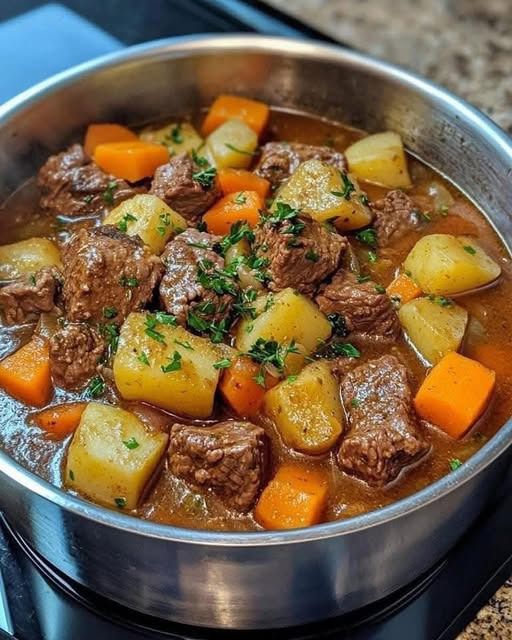Introduction
Stewed beef. Just the words conjure up images of hearty meals, comforting aromas filling the kitchen, and tender, melt-in-your-mouth goodness. But, let’s be honest, the world of stewed beef can seem a little intimidating. Which cut of beef is best? How long do you actually need to cook it? What about all those vegetables? Don’t worry, we’re here to demystify the process and guide you to stewed beef perfection. Get ready to impress your family and friends with a dish that’s both delicious and deeply satisfying.

The Fundamentals of Fantastic Stewed Beef
Creating a truly exceptional stewed beef dish boils down to a few key factors. From choosing the right cut of beef to mastering the art of browning, each step contributes to the final result. Let’s break it down.

Choosing the Right Beef
This is arguably the most crucial decision you’ll make. You need a cut that’s tough and sinewy because those are the things that break down during long, slow cooking, creating that wonderful, tender texture we all crave. The best cuts are:
- Chuck Roast: The gold standard. It’s well-marbled, flavorful, and becomes incredibly tender.
- Beef Short Ribs: Bone-in short ribs add richness and depth of flavor.
- Brisket: While often smoked, brisket can be wonderfully stewed, especially the point cut.
- Round Roast: A leaner option, but still benefits from long cooking times. Remember to trim excess fat.

The Importance of Browning
Don’t skip this step! Browning the beef is absolutely essential. It creates a rich, complex flavor profile and adds depth to the entire dish. The Maillard reaction (the chemical reaction between amino acids and reducing sugars that gives browned food its distinctive flavor) is your friend here.
Here’s how to do it right:
- Pat the beef dry: Moisture is the enemy of browning.
- Season generously: Salt and pepper are your best friends.
- Use high heat: Get your pan nice and hot.
- Don’t overcrowd the pan: Brown the beef in batches. Overcrowding will steam the meat instead of browning it.

Building Flavor with Aromatics
This is where your stew starts to sing. Aromatics like onions, carrots, and celery (often called a mirepoix) are the foundation of a flavorful stew. Sauté them until softened before adding your liquid. Don’t be afraid to get creative! Garlic, leeks, shallots, and even fennel can add unique dimensions to your stew.

The Braising Liquid
The liquid you use to braise your beef plays a huge role in the final flavor. Here are some popular choices:
- Beef Broth: A classic choice, provides a rich and savory base.
- Red Wine: Adds depth, complexity, and acidity. Choose a dry red wine like Cabernet Sauvignon or Merlot.
- Beer: Stout or dark ale adds a robust, malty flavor.
- Tomato Paste or Crushed Tomatoes: Contributes sweetness, acidity, and color.
Don’t be afraid to experiment! A combination of broth and wine is a great place to start. Remember to add enough liquid to almost cover the beef.

The Long, Slow Simmer
Patience is key. Stewed beef is all about low and slow cooking. This allows the tough connective tissue in the beef to break down, resulting in incredibly tender and flavorful meat. Simmer on the stovetop, in the oven (covered), or in a slow cooker. Aim for a gentle simmer, not a rolling boil.

Adding Vegetables and Finishing Touches
While the beef is the star of the show, vegetables add texture, flavor, and nutrients. Choose vegetables that can withstand long cooking times, such as:
- Potatoes: Yukon Gold or red potatoes hold their shape well.
- Carrots: Add sweetness and color.
- Turnips: A slightly bitter, earthy flavor.
- Parsnips: Sweet and nutty.
Add the vegetables during the last hour or so of cooking, depending on their size and density. You don’t want them to turn to mush!
For finishing touches, consider adding a bay leaf, thyme sprigs, or a splash of balsamic vinegar for extra depth of flavor. Taste and adjust seasoning as needed. A sprinkle of fresh parsley before serving adds a pop of freshness.

Conclusion
Stewed beef is more than just a meal; it’s an experience. From selecting the perfect cut of beef to mastering the art of browning, each step is a building block towards a truly exceptional dish. Remember to be patient, embrace the flavors, and don’t be afraid to experiment. Now, go forth and create your own stewed beef masterpiece! Find a cozy weekend, gather your ingredients, and enjoy the process. You won’t regret it. And remember, great stewed beef is even better the next day!

